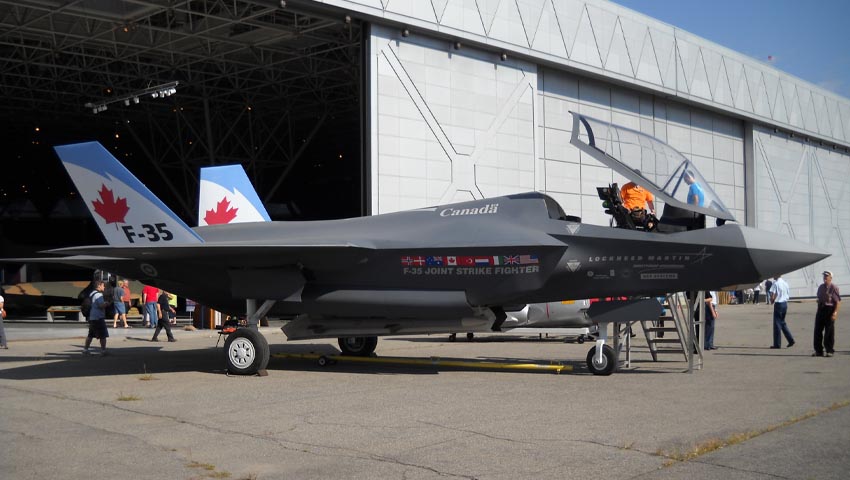Canada’s long-running, US$15 billion fighter replacement program appears to be edging ever closer to a decision, with the Lockheed Martin F-35 firming as the favourite for the second time in the program’s history.
To continue reading the rest of this article, please log in.
Create free account to get unlimited news articles and more!
Canada’s relationship with the multibillion-dollar F-35 Joint Strike Fighter Program has been one of heady highs and tumultuous lows, with the Conservative government led by Stephen Harper committing the nation to acquiring 65 airframes to replace the ageing 80 CF-18 Hornets in 2010.
However, the election of Liberal Party Prime Minister Justin Trudeau in 2015 spelt doom for the country’s participation in the F-35 program, with the Prime Minister declaring not to purchase the F-35, instead, focus on “one of the many, lower-priced options that better match Canada’s defence needs”.
This resulted in a multi-horse race to replace the Royal Canadian Air Force’s ageing CF-18s, drawing competitors including the Eurofighter Typhoon, the Boeing F-18 E/F Super Hornet, Saab’s Gripen and, of course, the Lockheed Martin F-35 Joint Strike Fighter.
Following the withdrawal of the Eurofighter in August of this year, the remaining contenders are furiously vying for the lucrative contract to supply 88 jets beginning in 2022.
Canada, like Australia, has enjoyed a boost to local competitive aerospace manufacturing as part of its participation in the multibillion-dollar program, with Canadian companies taking part in contracts worth an expected value of US$1.1 billion between the 2013 and 2023 time frame – with a total potential value of Canada’s involvement in the JSF program worth an estimated US$9.9 billion in 2013.
Another hurdle was a new requirement that the winning fighter must show it would be integrated into the joint US-Canadian air defence system NORAD.
While probably not an issue for the Super Hornet, it would surely have been one for the European contenders.
Canadian media highlighted the challenges faced by the European contenders, namely Airbus, stating: “Airbus would have been required to show how it planned to integrate the Eurofighter Typhoon into the US-Canadian system without knowing the system’s full technical details.”
Nevertheless, even Boeing seems to be having second thoughts about participating in the program, which was reported in Reuters in July this year by David Ljunggren, who alongside Airbus, formally lobbied Ottawa, expressing concerns about the current requirements of the contracting program – which both parties believe is rigged in favour of the F-35.
There are a number of advantages for Canada acquiring the F-35, with the aircraft expected to form the backbone of Western air combat capabilities for the better part of the next several decades – not just in the United States, but also with key Canadian NATO allies like the United Kingdom, Italy, Belgium and the Netherlands, and global partners including Pacific partners in Japan and Australia.
The Lockheed Martin F-35 Joint Strike Fighter is billed as a catalyst for the fifth-generation revolution, changing the face and capability of the Royal Australian Air Force (RAAF) and the wider Australian Defence Force (ADF).
For the RAAF, the F-35A’s combination of full-spectrum low-observable stealth coatings and materials, advanced radar-dispersing shaping, network-centric sensor and communications suites – combined with a lethal strike capability – means the aircraft will be the ultimate force multiplying, air-combat platform.
The F-35A – the variant chosen by the RAAF – will have a projected life of 30 years in service.
Ten nations are currently flying F-35s, including the US, UK, Italy, Norway, Israel and Japan. The firsts of Australia’s F-35A aircraft are now based on home soil after a period of training and development at Luke Air Force Base in Arizona USA, plus an epic Pacific Ocean crossing in December 2018.
More than 340 F-35s are operating today with partner nations, more than 700 pilots and 6,500 maintainers have been trained, and the F-35 fleet has surpassed more than 170,000 cumulative flight hours.
Over the coming years, Australia will purchase 72 of the advanced fifth-generation fighter aircraft as part of the $17 billion AIR 6000 Phase 2A/B program – which is aimed at replacing the ageing F-18A/B Classic Hornets that have been in service with the RAAF since 1985.

 Login
Login







